
ONE lit off for Red Hook on November 27, 2021 (new thing: I have decided to put an exact date on the photography in Forgotten NY posts, since this is made easier because the new edition of Photos, the Apple app I use to modify raw pix, displays the day each photograph was taken, in this case November 27, 2021).
Date of photography: November 27, 2021
Photos in batch: 139
I won’t be using all 139 of course, since I began and ended the walk in Carroll Gardens; those photos will make their way to separate posts. The thing to keep in mind here is that 11/27/21 was an overcast day in the darkest time of year and so, these photos are a bit on the dullsville side; in a few cases, I adjusted the Photoshop levels to punch things up a little. During teh week I am strictly confined to Forgotten NY headquarters in Little Neck but with good reason, a salary job writing for Marquis Who’s Who. Thus, the weekends are for FNY jaunts, miserable weather or pleasant.
I have journeyed in Red Hook not infrequently, going back to the days when I lived in Bay Ridge and reached it by bike. Like DUMBO, which I explored a few weeks after Red Hook, in recent years many of its rough edges have been straightened out. I had not been to the Red Hook waterfront since before the COVID Pandemic, though in July 2021 I got as far as Red Hook Park before turning around. It’s always been my belief that the spread-out Red Hook Houses have acted as something of a check on overgentrification, though the new waterside IKEA store has suburbanized the Hook somewhat.
It’s a shame that only two structures in Red Hook are landmarked: the Red Hook swimming pool and the Clay Retort on Richard and Van Dyke, neither of which I talk about here.
GOOGLE MAP: RED HOOK, NOVEMBER 2021
Today’s Red Hook journey began at the Coles Street footbridge, which begins at Henry Street opposite 4th Place and spans the very wide Gowanus Expressway which at this point is splitting up, with one piece heading for Queens as the Brooklyn-Queens Expressway and the other entering Manhattan via the Brooklyn-Battery Tunnel. Though the Carroll Gardens-Red Hook border is undefended, but it’s a difficult crossing in most places, as navigating pedal to the metal Hamilton Avenue is rather difficult on legs or on a bicycle. The Coles Street footbridge, under rehabilitation in November 2021, is the optimum means of stealthily arriving in The Hook.
Alighting from the Coles Street footbridge you can spot the stolid brick Public School 27, at Hicks and Nelson Streets, or rather its older building; a “new” Ps 27 was built a block away, on Huntington, in the 1930s. The date of construction, 1890, can be seen on the Nelson Street entrance. On the Hicks Street side, the “PS 27” on the pediment seems to have been re-letered in haste.
I have discussed Luquer Street in Forgotten NY before, mainly for its missing “e” (it’s spelled Luqueer on old maps and gravestones around town) and its pronunciation: Loo-ker, Loo-quer, or Loo-queer? Old timers favor the latter.
In the western stretch of Luquer between Hicks and Columbia Streets, though, is another puzzlement: s series of nonstandard post-top lamps. When the Department of Transportation installs midblock post tops, it generally employs Type B park lamps, as it does on Atlantic Avenue. Here, though, the lamps are a different make entirely; I wonder if the block association pit them there? In any case I think they’ve been there awhile, and I want to stop by at night sometime to see how they light up. The DOT has placed some No Parking signs on at least one of them.
Defonte’s is one of the most heralded and celebrated sandwich shops in Brooklyn, at Columbia and Luquer Streets, but I have never been able to sample because I always seem to be in these parts on Sunday, the one day they are closed. Indeed, when I went past, a couple of passing bros let out noises of disappointment as they had apparently been aiming for a Defonte’s feast.
Defonte’s is really a foundational text of the Italian-American experience, a place where, starting in 1922, huge spiced hams were steamed, red peppers were roasted, and all sorts of prehistoric olives were brined and chopped up into spreads for giant loaves of bread, decades before the vast majority of Americans knew there was something called “pizza.” The oil-and-vinegar-stained Nicky Special, with capocollo, salami, and creamy fried eggplant (also Defonte’s “hot salad,” threaded with sliced cherry peppers and marinated mushrooms) is one of its oldest, most enduring house specialties. [New York Magazine]
Defonte’s looked like this in 1940, though its name wasn’t on the awning sign.

An ad at Columbia and Commerce Streets that probably won’t prove popular with the burgeoning Brooklyn anti-motor vehicle crowd. (Just about anything is more fun than the G train.)
Both Greenwich Village and Red Hook have short Commerce Streets, located in areas that are, or were, hubs of manufacturing. It’s become something of a trend during the past 10-20 years to situate concert and event spaces in out-of-the-way manufacturing areas, and Commerce Street has one, The Regency, whose mission statement is a slight bit pretentious:
We cultivate regenerative culture by providing education, resources, and a platform for community to flourish.
REGENERATION: A regenerative culture aims to evolve today’s society by embracing the indigenous worldview of seeing the Earth as alive and community as sacred, to help reform our industries and our politics to take better care of our world and our people.
Next door on Commerce Street can be found one of the many red hooks in Red Hook.
Heading back to Columbia Street at Delavan Street, you find one of those repurposed solid brick factory buildings of which I am so fond, the former Monarch Luggage Factory, built in 1920 and refit for apartment living…not very effectively, if you trust this article in The Brooklyn Paper. I have a history with this building: I have never lived here, but eons ago, I was interviewed for an article in The New York Post by the late great Joe Cunningham. We were looking around for a decent spot to take a photograph and we went to the roof of “The Monarch” and got me with a backdrop of the Red Hook “R Building” (see below).
I also have a history with The Brooklyn Paper, as I dealt with its longtime editor Ed Weintrob… while I was in college! At the time (1979-1980) The Brooklyn Paper was strictly a print entity, as was the St. Francis College newspaper, The Voice, which I edited. The Brooklyn Paper also hired out as a printing service, and we used it for The Voice. It was rewarding once a month to see big bundles of newspapers delivered to our office on the mezzanine which I would then set out on chairs in the school cafeteria.
At the time The Brooklyn Paper employed a cartoonist named Batton Lash; one day I asked him if his middle initial was “I.” He wasn’t amused. Hey, his real name was Vito Marangi!
I consider this building the symbol of Red Hook, the former E.J. Trum Building, #80 Richards at Delavan, which I call The R Building. I’ve been nattering on about it for 22 years. In 2000 I wrote:
When John Turano bought the building in 1978, intending to make it a furniture manufacturer warehouse, the previous business to occupy the site was paper-goods manufacturer E.J. Trum, and Trum’s gigantic sign occupied the frame. When Turano attempted to pull down the letters to install his own sign, the “R” wouldn’t budge, and the lone “R” has been a part of Red Hook’s landscape for 22 years. The first period is still in place, as well.
Today it seems to be tenanted for a number of small businesses, but it wouldn’t surprise me to see it”go condo.” Presently, a leasing company is offering “creative and commercial lofts” and even uses the R in its ads.
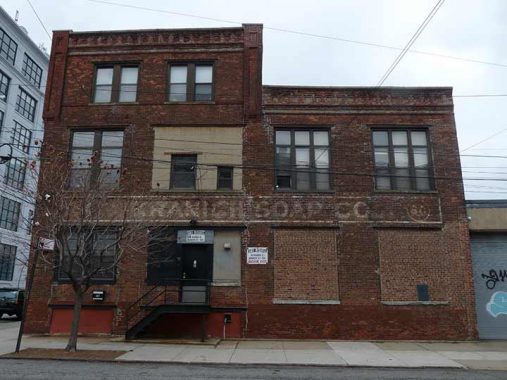
On the northeast corner of Richards and Delavan is the former Kranich Soap factory. The chemical company was founded in 1921 as Kranich Chemical by German immigrants Augustus Kranich (1870-1956) and his son, Herbert Kranich (1894-1975). The factory was originally located on 9th Street in Park Slope, but moved west to this location in 1924, becoming Kranich Soap, and remained until 1963.
The Indispensable Walter Grutchfield has much more.
The SW corner of Richards and Delaan is a vast weedy lot, protected by a cyclone fance and sporting a huge cellphone relay tower. On the corner is a metal sculpture featuring a motorcycle helmet and the words SHARON BIEN, 5-19-03. It commemorates a woman who was killed when a car hit her motorcycle at this corner on that date. Ms. Bien was a teacher at PS 225 on Beach 110th Street in the Seaside neighborhood on the Rockaway Peninsula; I do not know her connection to Red Hook.
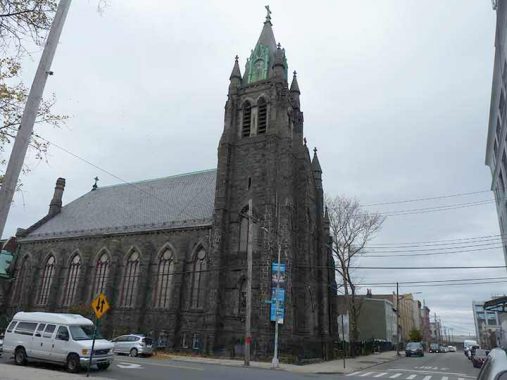
The Roman Catholic Church of the Visitation of the Blessed Virgin Mary was established in 1854 to serve the Irish and Italian dock and factory workers in the Red Hook section of Brooklyn. The first church, located on Ewen [now Verona] and Van Brunt Streets, was dedicated by Bishop Loughlin on October 29, 1855.
A second church, built of gray stone and measuring 175 feet long by 60 feet wide, was erected in 1878, but was destroyed by fire on July 12, 1896.
The present Gothic church was built in 1896 on Richards Street between Verona Street and Visitation [Place], and is across the street from Red Hook Park. A two-alarm fire damaged the interior of the church on December 30, 1949 when a 9-year-old boy accidentally dropped a hot taper into the creche in front of the altar. NYC AGO
The street adjoining the church on its south side, Visitation Place, was renamed from Tremont Street in 1909. The names of Roman Catholic churches can often be indecipherable to non=Catholics or non-Christians, so by way of explanation: while pregnant with Jesus, Mary visited her cousin, Elizabeth, and while there felt the child Jesus moving in her womb, as unborn babies are wont, and according to Church doctrine the event signified that the child was without original sin (which has been applied to all humans by God since the fall of Adam and Eve). The Feast of the Visitation of the Blessed Virgin Mary is celebrated on May 31st each year.
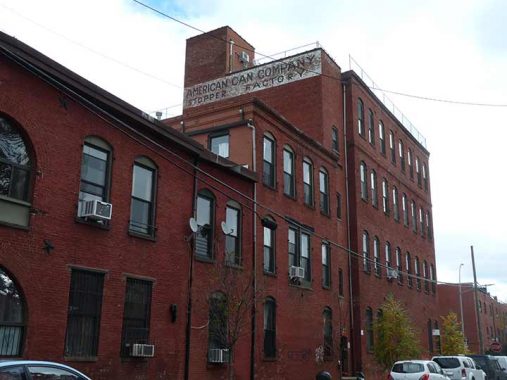
The American Can Company on #20 Verona, between Richards and Columbia, adjacent to the Monarch Luggage building, occupies a. building formerly home to the Chesebrough Manufacturing Company, of which you’ve probably never heard, but you may well have used what they manufactured: petroleum jelly, marketed under the name Vaseline. The company constructed this brick building in 1885. Richard A. Chesebrough was in business as a manufacturer in Red Hook beginning in 1861. American Can was in the building beginning in 1902; not sure when the left. Vaseline is today distributed by Unilever.
If anyone’s research can be considered “indispensable” other than Walter Grutchfield, it’s that of a woman named Maggie Blanck, whose reams of research on Red Hook and other locations is freely available on her website. If you’re into neighborhood histories, you’ll spend hours there. If anyone knows who Maggie Blanck is and can put me in touch with her, Comments are, as always, open.
Pioneer Street runs from Coffey Park at Richards Street west to the waterfront and boasts one of Red Hook’s rare runs of attached row houses, with shade trees. No doubt these homes were occupied by dockworkers and their families when Red Hook had working docks. The pictogram sign either refers to Red Hook’s cruise ship berth or a ferry stop, which are each on the west end of the street.
111 Pioneer, between Richards and Van Brunt, is a very old symbol of the contributions of Scandinavians to the Brooklyn waterfront areas, as it was once the Norwegian Seaman’s Church. The church was established by the Norwegian Seaman’s Mission, which was based in the old country, in 1878 and installed Ole Bugge Asperheim as the first pastor. He purchased this church building that year: it was old even then, as it was formerly a Dutch Reformed Church, and this street was then called William. The church moved out in 1983 and today can be found at 317 East 52nd Street in Turtle Bay. Today the building is occupied by artist Chico MacMurtrie’s Amorphic Robot Works.
Some more of Pioneer Street’s row houses. Note that some have been renovated and been added to: Red Hook does not have a uniform code as little of it has ever been landmarked. We will see more of what this (lack of) policy has brought later on.
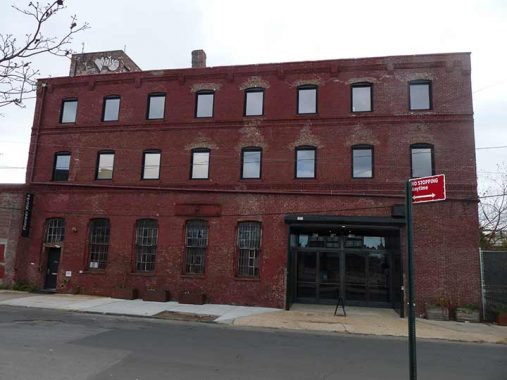
The last remaining building of the former Pioneer Iron Works can be found at Imlay Street. In 1929, Pioneer Street was still called William and was likely renamed for the iron works. They were apparently founded here in the mid-1860s.
Today the building is home to the Pioneer Works cultural center, established in 2012.
Today, I didn’t have time to enter the Portside Park area, located in the former Clinton Wharf at the last bit of working waterfront remaining in Red Hook. The area features the tanker ship Mary Whalen, which is open to the public and serves as the Portside Park office. A NYC Ferry stop is also here. The signage on the fence indicates the waterline during Hurricane Sandy in 2012.
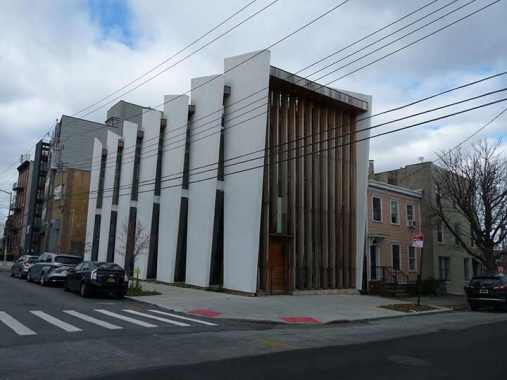
Since no area in Red Hook has been landmarked there’s something of a Wild West atmosphere as far as architectural styles on new buildings such as this one at #202 Conover Street at the corner of Dikeman. It’s actually going to be an art gallery constructed by a Manhattan pediatrician. The gallery will feature events and concerts and will serve food; not sure about a liquor license. See the adjoining building for a contextual Red Hook dwelling for the past century or so.
Not long ago, I was surprised to discover that “Conover” is an anglicism of the Dutch name Kouwenhoven, which can be found all over former NYC maps.
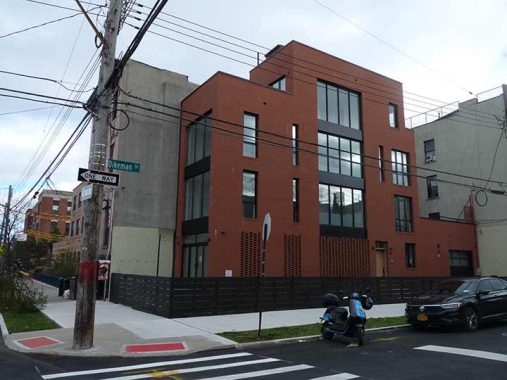
Directly across Conover from the new museum is this new building which is perhaps more typical of new office and residential construction in NYC in the early to mid-2020s. Both these new buildings were constructed on what forn many years were empty lots.
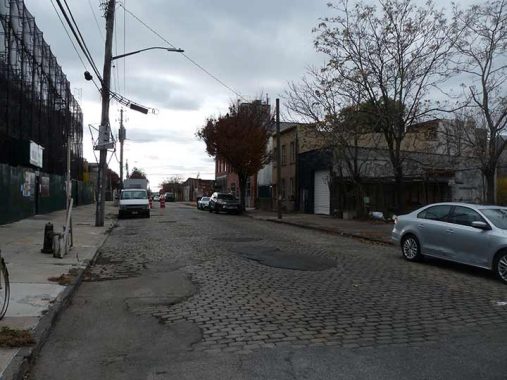
Conover Street, looking south from Dikeman. The neighborhood still has plenty of Belgian block surfaces.
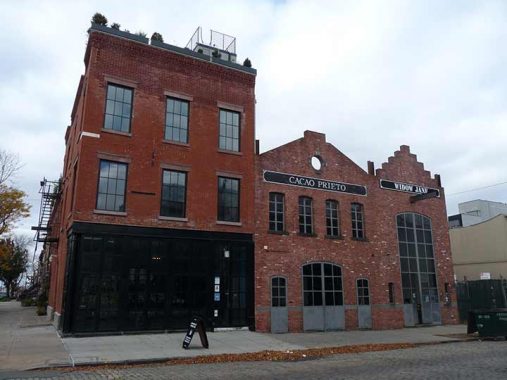
These buildings at #214-220 Conover at Coffey host the Botanica at Widow Jane distillery bar and the former Cacao Prieto, which manufactured chocolate and liquor hand crafted and distilled on premises. A few years ago I passed up the chance to get free chocolate samples here and I won’t get that chance anymore. Years ago, the bar was a parachute factory and likely a large number of businesses have passed through the space.
The two buildings on the right are relatively new, while the one on the right, #220, dates to the 1800s and still has a chiseled “Partition Street” sign on it, Coffey Street’s former name.
These murals appear on walls at Conover and Coffey Streets; it’s probable they were commissioned by the distillery bar management.
Some latter-day painted ads at Conover and Van Dyke streets for still-extant businesses, Cornell Paper and Box Company and Steve’s Key Lime Pies, which is open in the warm months in the waterfront area; I can vouch the pies are excellent.
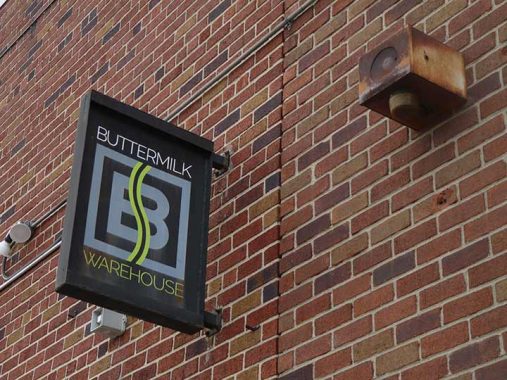
The name of the Buttermilk Warehouse (where no lactic-oriented products are stored) may seem to be perplexing at first; but then consider the narrow body of water separating Red Hook from Governors’ Island, known as Buttermilk Channel: in the old days of sailing ships, the wave action bounced ships around enough to make butter out of cream with the leavings being buttermilk; these days a bacterial culture is added to speed along the process.
Much of Red Hook’s industrial past has been recently lost. See Nate Kensinger’s report in Curbed.
[nggalllery id=11831]
A Red Hook tradition of sorts the past decade or two has been a proliferation of hand painted and lettered signs, with these two pointing to a wine bar.

The Balzano family’s bar on Conover between Beard and Reed Streets has been a Red Hook waterfront institution for three generations. For most of them Sunny Balzano was a constant presence. His family has owned the business for decades, with his uncle John keeping the bar open every day until 6PM, serving sandwiches and Italian food to longshoremen and dock workers. Gradually, the Red Hook docks became silent as the shipping industry moved across the harbor to New Jersey, depriving the old place of many of its old customers, but Sunny and John discovered that a new clientele of artists and musicians from nearby Williamsburg was coming to the bar.
After John passed away in 1994, Sunny ran it as a nonprofit club featuring musicians and local performers, opening Friday nights only, and after acquiring a new liquor license and renovating the bar, Sunny was able to open a couple other nights a week as well. The bar is now a neighborhood gathering place for its new breed of customers.
Since Sunny’s death in 2016, his widow Tone Johansen has kept the place going. Here’s a look in 1940, when it was known as John’s Restaurant.
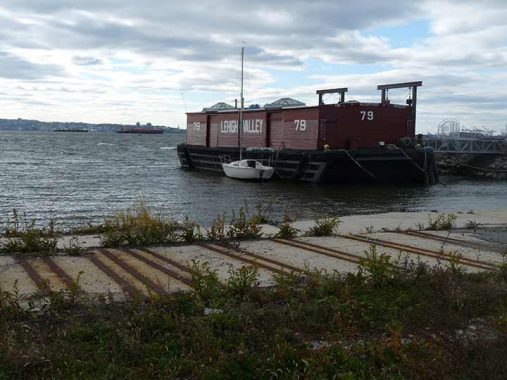
Lehigh Valley Barge Number 79, a 30’x90’ railroad barge built in 1914 with a wood exterior, is the last of its kind still in existence. During New York’s era as a world class port it transported goods across the harbor. It lay idle for three decades off the coast of New Jersey, but since 1994 it has served as a floating classroom, art exhibition and concert space, and center for parties and weddings. The barge was rescued by David Sharps in 1985.
Known primarily as a supermarket for the. better part of a decade (Food Bazaar and before that, Fairway) this huge waterfront building started out as the Red Hook Stores, New York Warehouse and for many years was used to store cotton. The building suffered numerous fires as cotton is a highly flammable commodity.
The brick structures known collectively as the Beard Street warehouse along the waterfront were built by William Beard and Jeremiah and George Robinson in 1869, and are among the very few warehouse/piers remaining in New York City. Beard transformed what had been submerged marshland into Erie Basin, a huge seaport and storage depot. Today a number of small businesses and art galleries occupy these buildings. (I was intrigued by the radial wave wall bracket lamp reproductions.)
In the late 1990s, Robert Diamond attempted to begin a trolley line here and actually laid tracks. He would have used vintage trolley cars he had accumulated over the years, and had plans to run the line up Columbia Street and perhaps run it on the abandoned LIRR tunnel under Atlantic Avenue. The last of the cars from the aborted project, from the Boston “T”, can be found behind the Fairway that opened in the Beard Stores in the early 2000s. Tracks and trolley poles installed by Diamond and his team are still in place, but no longer used. Diamond, who rediscovered the Atlantic Avenue LIRR tunnel in 1981, passed away in 2021.
“The bay was angry that day my friends.” On the darkest day of the year, it made for some compelling pictures. Though I am convinced I would have done Forgotten Paducah or Forgotten Omaha had I been born in those places rather than New York; I’m more of an infrastructure enthusiast than a New York city booster: but I am forever grateful I was born in a place that borders water.
Yes, I did visit the Ikea complex, on Beard east of Dwight, a place that may have put Red Hook on the map as much as public consciousness is concerned. After buying some pieces from their Hicksville outlet in the 1990s that I put together myself (and jury-rigged them; I’m not a carpenter) I gave them up for good, though I like to wander around therein to see what pieces are on offer, as well as their Swedish meatball lunch. Though I find the cafeteria-style ordering system confusing in that I had broccoli plopped on my plate before I had a chance to say no. I just swallowed the stuff. Ikea is ingenious, as the signage proffers the promise of the men’s room and the exit around every corner, which when you get there, shows you more furniture. Genius!
Ikea took the place of the Todd Shipyards, which had its own dry dock.
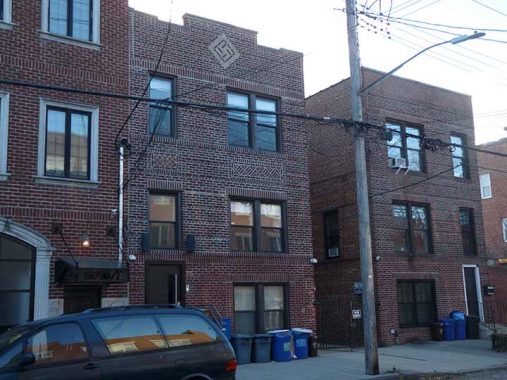
#73 Coffey Street, of Richards, is another commonplace 3-story Red Hook brick dwelling…which has a swastika at the roofline. Fear not, there are no Hitlerites here. The swastika was a symbol of good fortune before the National Socialist Party of Germany corrupted it in the 1930s, and you see the symbol on plenty of buildings constructed in NYC before that time.

A bar on the corner of Van Brunt and Dikeman is named Fort Defiance, which was a real place in Red Hook.
The complex consisted of three redoubts on a small island connected by trenches, with an earthwork on the island’s south side to defend against a landing. On July 12, 1776, the British frigates Rose and Phoenix and the schooner Tyrol ran the gauntlet past Defiance and the stronger Governor’s Island works without firing a shot, and got all the way to Tappan Zee, the widest part of the Hudson River. They stayed there for over a month, beating off harassing attacks, and finally returned to Staten Island on August 18. It would appear that gunfire from Fort Defiance did damage to the British ships.
Though I skipped Van Brunt Street, Red Hook’s Main Street, for the most part today, you can find plenty of material on my previous Red Hook posts (and you can load even more by pressing the button at the bottom of the link.
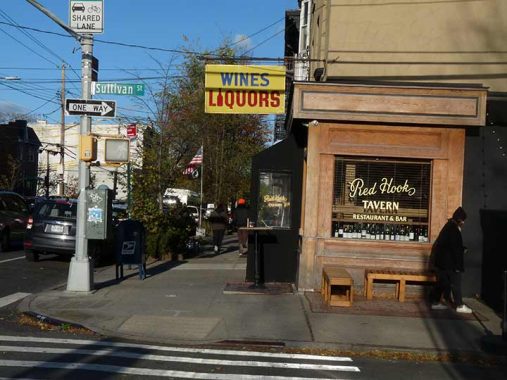
The Red Hook Tavern , Van Brunt and Sullivan, took over a former liquor store space and kept its former sign, with the bottle instead of the I in Liquors. The place has acquired a reputation for Red Hook’s best burgers.
Time to head back to Carroll Gardens, and its subway (the subway has resolutely stayed out of The Hook) just as the sun comes out but not before a look at the Van Brunt Firehouse, #199 Van Brunt at Seabring. It opened in 1872 as Ladder #1, Hook #2 in the Brooklyn Fire Department, later the FDNY Hook & Ladder #101, Engine #202. Currently it is home to the non-profit Friends of Firefighters, formed in the aftermath of the 9/11/01 terrorist attack. The organization offers free and low-cost health services to current and retired FDNY members. Red Hook’s active firehouse is a block away at Richards and Sebring.

I intend to be back in Red Hook in (literally) brighter days.
As always, “comment…as you see fit.” I earn a small payment when you click on any ad on the site.
1/9/22

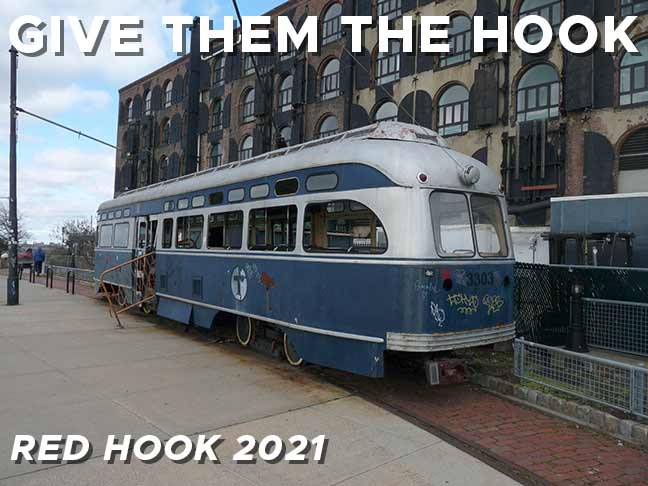
14 comments
The trolley car in the photo is indeed a refugee from Boston’s transit system (known as the “T”, officially the Massachusetts Bay Transportation Authority or MBTA). It is a 1951 model PCC car that Bob Diamond’s group repainted into the dark green and silver paint scheme that Brooklyn’s PCC cars sported from the late 1940s until the cars were retired in October 1956. In Boston the PCC cars were originally painted in a dark orange and cream livery; a small fleet of PCC cars still run there. For a time Boston PCCs were indeed painted green, but a different shade than in the photo.
What does PCC mean? The letters stand for President’s Conference Committee, a US mass transit industry group created in 1929 by executives who wanted to develop a modern (1930’s style) trolley car to stem the tide of trolley to bus conversions that were beginning to occur in many US cities. Brooklyn was then the province of the privately-owned BMT system, which operated most of the borough’s subways and els, and its entire trolley and bus network. The BMT was firmly committed to trolleys and served as a working laboratory for the PCC engineers to design and test their new car. Based the PCC’s work, BMT received the first mass production PCC car order (100 cars) in 1936. The new cars were a hit with the BMT management, its work force, and the riding public – a rare endorsement from all parties.
Unfortunately, there was a significant stumbling block. Mayor Fiorello LaGuardia was opposed to trolleys and felt that buses were the modern way to provide street-based mass transit. He promptly squelched the BMT’s attempts to buy 500 more PCC cars because NYC government was angling to buy the BMT (did occur in 1940). The 100 Brooklyn PCC cars did their required 20 years of service and ran their last trips between November 1955 and October 1956. The cars ran on Coney Island Ave., Church Ave., and McDonald Ave.
Unlike Brooklyn, Boston embraced the PCC car and had a large fleet (340 cars) that provided service there for generations, using Boston’s pioneering light rail lines (underground subways in Central Boston), and on the street surface beyond. A small fleet of World War II era PCC cars (about a dozen) have been rebuilt and still operate on a single 2.6 mile route, the Mattapan-Ashmont High Speed Line, that is a feeder line to Boston’s busy Red Line subway. A unique feature of Boston’s PCC cars, visible in the photo, is the left side door, required at certain subway stations where the platform was on the left side, much like many NYC subway stations. Boston’s current fleet of modern light rail vehicles continue to have this feature.
You overlooked Joe (“Crazy Joe”) Gallo, perhaps Red Hook’s most infamous citizen.
* https://en.wikipedia.org/wiki/Joe_Gallo
It’s a shame NYC Landmarks Commission gives short shrift to the “outer boroughs” and to industrial NY.
Years ago while working at the bus Command Center in ENY, I would take calls for buses that broke down in the Red Hook area. In the winter the cold weather made it hard to re-start the buses. The mechanics had a hard time finding the terminal stop.
In recent years I like to travel into redhook and have lunch in the back of the supermarket on the dock.
I’ve had the key lime pie that is made in the area. As of yet I have not tried the new Lobster house.
The electric car saleroom is displayed in Red Hook. The city views are breathtaking. The area is a hidden gem.
Nice work, as always. The Lehigh Valley RR barge and Staten Island backdrop was used in a recent episode of “Godfather of Harlem” set in 1964. The barge and almost unchanged SI waterfront behind it was a nice period touch.
Regarding Buttermilk Channel’s name origin, I heard it was called that because farmers would graze their milk cows on Governor’s Island and wade across the channel at low tide to milk them. Could be true, may be a total fantasy, who knows? As for 202 Conover, though it’s new, it has 1969 written all over it. Everything old is indeed new again!
Went swimming at the red hook public pool with my family a lot when I
was a child.We were the only white people there but we never had any
trouble.About 13 years later I walked out of the gate at the Todd yard in
1980 and past that same pool at night and all deserted and those memories
came tearing in.I was a seamen on old victory ship there and a lot of the
crew were scared to leave the ship on account of the n’hood and I’m
going Dudes! Whats the problem?I used to swim here as a kid!And most
of these guys were from NY!(but not from B’klyn of course)can you believe
those clowns?
That area of north sunset park had a lot of scandinavian seamen living there.
There used to be a catholic church at Rapelye and Hicks st. Our Lady of Sailors
It had this wonderful mosaic above the door.The steeple was made to
resemble a lighthouse.Very nautical looking.Torn down to pay for lawsuits agin
the church
Chris:
How old are you? Victory ships went out of both military & civilian service decades ago (see research posted below). When did you reassure your shipmates? The only three surviving victory ships became museums quite some time ago. Two are in CA, & one is in FL). According to your sequencing, 1980 was 13 years after your last family visit to the Red Hook public swimming pool; WW2 was ended in 1945 & victory ships were decommissioned. The last one left active service in 1974. Click on these links: https://en.wikipedia.org/wiki/USS_Sherburne_(APA-205). As for the rest of that fleet:
https://en.wikipedia.org/wiki/USS_Sherburne_(APA-205)
“Listen. Billy Pilgrim has become unstuck in time” Kurt Vonnegut “Slaughter House Five”
https://en.wikipedia.org/wiki/Victory_ship
I saw the Formula E races here over the summer, one of the automakers “borrowed” an older building to display their wares. I went inside as an excuse to look at the insides, the cars were just a happy bonus.
Ive gotten this before.People think you must be at least 95.I am
64.I wasnt getting anything at the union hall so I put in for the msc,
Idlers at the hall told me not to.”They suck” they said.The msc held
onto a lot of antiques.A lot of their stock was ww2 vintage vessels,
Victories,T-2 tankers,C-4 cargo ships. that were run to Im pretty
sure the easrly 90s.I was a marine fireman(fancy name for a
boilertender)Also like the fireman on a steam locomotive.Theres
also that company that ran 2 T-2s in the gulf bringing sulphur to
Galveston and Tampa to at least the 80s.I been on one when it
was being converted from steam to diesel.And dont forget the
Army!I bet they had some antiques too!.We were about 2 weeks
at Todd for repairs,then we split.Late 81?Would have to think really hard
the excact time.Oh yeah,the 2 tankers were the Louisiana Sulphur
and the Louisiana Brimstone.Someone told me their House flag
had a picture of the Devil on it but i dont believe that.Reassure
the crew?I was almost ashamed of them.But i got to admit,none
were from bklyn.All else queens,the bronx,manhattan.They took
cabs from the ship to the subway they were so scared.I spent
a lot of time there at the Montero bar was not too far away in the
Heights.Borrowed the ships bicycle to go there.
OK, Chris, you’ve persuaded me. Six years ago there was a film about a T-2 tanker catastrophe based on a true story, “The Finest Hours” . Click the link below for more details:
https://time.com/4197131/the-finest-hours-true-story/
It was a critical & commercial failure but I loved it & so will you (via Net Flix?) BTW: my father worked in the Brooklyn Navy Yard before WW2. He remained there as a civilian until 1943 when he became one of the few to be drafted into the Navy because Admiral King’s active anti-submarine warfare had successfully defeated U-boat wolf packs. As a petty officer, he did the same type work in the Bremerton, WA navy yard through the end of WW2. For your sake, I hope that you’ve moved on from Brooklyn & that you’re enjoying retirement somewhere along the Gulf coast. Thanks for sharing.
Sorry,I should have been more informative.
I was a civilian working for the MSC(military sealift command)which is a
fleet of navy ships manned almost entirely by civilians,just like the Federal
civil service.The govt. had a large inventory of ships left over from the war
which the Navy sold off to private sector,the rest went into mothballs.
Confused as to why?I dont have time to explain.And get this,the Army
has(or had)a fleet of freighters,etc. manned by soldiers.(except for a civilian
captain)Look it up.
“I just love working on these little Victories.They’re so cute”
—-what a shipyard worker in Norfolk,Va once told me
No apology is necessary; you’ve been more than informative. You’ve had an interesting life. Thanks for sharing this & remember: “Knowledge is power”.
Kevin, I have not contacted Maggie in a while but I have her email as maggie@maggieblanck.com
Publish this or not, your choice.
I went to visit Red Hook when I moved to NYC…. Why ? Because I wanted to see the neighborhood JOEY GALLO was born and raised in ! ~ That was in the 1980’s. Then, in 2001 I started going to Greenwood Cementary to visit him . There were two Joseph Gallo’s buried there and first time I went to visit him as I just enter through 5th avenue, waved down a man in a utillty vehicle asking him is he could lead me to the J G that I wanted to visit. He said ” the gangster?” and i said YES, but I NEVER perceived Joey as a gangster & still don’t ! ~ He told me to follow him and he took me a on long race around Greenwood. LOL ! Yet, Joey is buried quite close to the entrance! Then, I didn’t believe is was the right J G gravesite because no large headstone and the man told me THIS is it ” I was here during the burial and the Feds. were climbing all over that fence”. I stared at his face trying to see how sincere he was and thinking ” you were 5-10 years old and saw that.. that was 1971″ ??!!! BUT, then I saw Larry ( Joey’s brother ) & Mary (Joey’s mother} graves right beside him!!!.>>. it WAS JOEY’s resting place !!! I thanked the man who lead me there and ran over to him as he was about to get back in his vehicle and thanked him again offering him a twenty dolllar bill for bringing me to the right place… he just turned his head saw the 20 smiled sweetly and left..didn’t take the money !!! ~ About a week later I looked for more info of the internet about Joey — and found a photo of him and couldn’t believe my eyes >>> It was the man who lead me to the grave !!!!!!!! REALLY… I don’t lie ! ~~~ Lot more to share about visits and miracles at Joey’s grave site ! ~ @ Forgotten New York ….. PLEASE put up a photo of the Church where Joey was born near !!!!! THANK YOU & BLESSINGS , if you do that, I will return with SO much more about JOEY > KING OF THE STREETS !!!!!!!!!!!!!!!!!!! >> 1. MIRACLES at his gravesite 2. Police officer that share same last name as Joey, but not related and how Joey protected him 3. All about Joey’s lion !!!!!!!!!!!!!!!